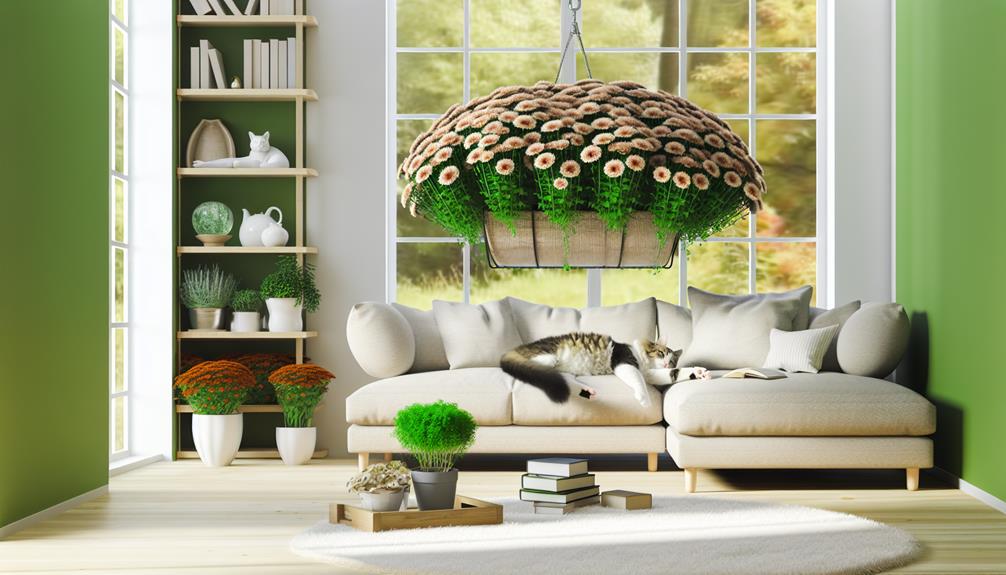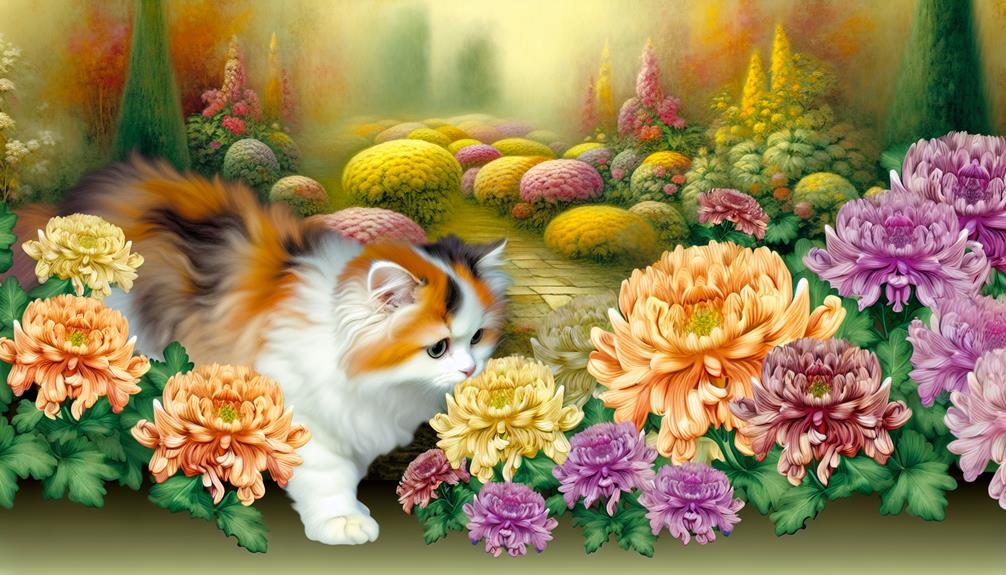Did you know that chrysanthemums, commonly known as mums, rank among the top ten plants that are toxic to cats? If you've got a feline friend and a passion for gardening, you might want to reconsider having these vibrant flowers around. Mums contain compounds like pyrethrins and sesquiterpene lactones, which can cause serious health issues for cats. Symptoms can range from mild gastrointestinal upset to severe neurological problems. You're likely wondering what steps to take if your cat ingests part of a mum, or which plants are safer alternatives. Let's explore this essential information further.
Toxic Compounds in Mums
Understanding the toxic compounds in mums (Chrysanthemums) is vital for cat owners aiming to guarantee the safety of their pets. Chrysanthemums contain several chemical properties that can be harmful to felines. The plant's toxicity primarily stems from pyrethrins, sesquiterpene lactones, and other irritating substances. Pyrethrins, commonly used in insecticides, can cause severe reactions in cats, even in small amounts. These compounds are naturally present in the flower heads and can be particularly dangerous if your cat ingests any part of the plant.
From a plant safety perspective, it's important to recognize that not all parts of the mum are equally toxic. The leaves, stems, and flowers each contain varying levels of these harmful chemicals. However, the concentration of pyrethrins is highest in the flower heads, which are often the most attractive part of the plant to curious cats. Additionally, sesquiterpene lactones can cause significant irritation to the skin and mucous membranes, further compounding the plant's overall toxicity.
For cat owners, minimizing the risks associated with Chrysanthemums involves understanding these chemical properties and taking appropriate precautions. Even minimal ingestion or contact with the plant can lead to adverse health effects. As a result, it's advisable to keep mums out of reach of your pets or opt for non-toxic alternatives. Employing plant safety measures is vital to prevent accidental exposure and maintain a safe environment for your feline companion. This proactive approach not only protects your cat but also helps maintain a harmonious and hazard-free living space.
Symptoms of Poisoning
Recognizing the symptoms of poisoning in cats is vital for prompt and effective treatment. When a cat ingests toxic compounds from mums, their behavior can change rapidly, signaling distress. Clinical signs often manifest within hours and can escalate quickly, so monitoring your cat's behavior closely is essential for plant safety in your home.
Typical symptoms of mum poisoning in cats include:
- Gastrointestinal upset: Vomiting and diarrhea are common, often presenting soon after ingestion.
- Neurological symptoms: Look for signs such as uncoordinated movements, tremors, or seizures, which indicate severe toxicity.
- Respiratory distress: Cats may exhibit rapid breathing or coughing, suggesting respiratory compromise.
- Excessive drooling: Increased salivation can occur as a direct response to irritation in the mouth and gastrointestinal tract.
- Behavioral changes: Lethargy, depression, or unusual aggression can be indicative of poisoning.
These symptoms are not exhaustive but represent the most frequently observed clinical signs. Gastrointestinal disturbances are often the initial indicators, while neurological and respiratory symptoms suggest a more severe toxic reaction. Drooling and behavioral changes can be subtle but are equally important to note, as they provide early clues to underlying issues.
It's imperative to differentiate these symptoms from other common feline illnesses to avoid misdiagnosis. A thorough understanding of cat behavior and plant safety can greatly mitigate risks. If you suspect your cat has ingested part of a mum plant, recognizing these symptoms early can make a considerable difference in their prognosis.
Avoid the temptation to wait and see if symptoms resolve on their own. Early detection and swift action are key to ensuring your cat's health and safety.
Immediate Actions to Take

When you suspect your cat has ingested mums, immediate actions can greatly impact their recovery. The first step in an effective emergency response is to quickly assess your cat's condition. Look for symptoms such as vomiting, diarrhea, drooling, or lethargy. If any of these signs are present, it's vital to act swiftly.
Do not attempt home remedies or induce vomiting without consulting a veterinarian. Incorrect actions can exacerbate the toxicity and worsen your cat's condition. Instead, contact your veterinarian or an emergency veterinary clinic immediately. Provide them with essential details, including the amount of mums ingested and the time of ingestion.
While awaiting professional guidance, make sure your cat remains in a safe, calm environment. Minimize their movement to avoid further stress or injury. If the veterinarian advises bringing your cat in for an examination, transport them in a secure carrier to prevent additional harm.
Upon arrival at the veterinary clinic, the veterinary care team will likely perform a thorough evaluation. Diagnostic tests such as blood work and imaging may be conducted to assess the level of toxicity and organ function. The treatment protocol typically involves decontamination procedures, such as activated charcoal administration, and supportive care, including intravenous fluids to manage dehydration and electrolyte imbalances.
Prompt veterinary care greatly increases the likelihood of a full recovery. Following the emergency response and initial treatment, adhere to the veterinarian's recommendations for follow-up care and monitoring. By acting rapidly and seeking professional help, you can effectively mitigate the risks associated with mum ingestion and safeguard your cat's health.
Safe Alternatives to Mums
After addressing the immediate actions following mum ingestion, it's prudent to contemplate safer botanical alternatives to prevent future incidents. Confirming your home remains a safe haven for your feline companion involves selecting pet friendly flowers and indoor plant options that won't pose a toxic threat. Replacing mums with non-toxic varieties can greatly reduce the risk of poisoning and allow you to maintain a vibrant living space.
Here are some safe alternatives:
- Spider Plant: A resilient and popular indoor plant option, the spider plant (Chlorophytum comosum) is entirely non-toxic to cats and easy to care for.
- Areca Palm: Known for its lush, tropical appearance, the Areca palm (Dypsis lutescens) is a pet friendly flower that adds greenery without risk.
- Boston Fern: The Boston fern (Nephrolepis exaltata) offers a feathery texture and is safe for feline friends, making it a great indoor plant option.
- Orchids: Orchids (Orchidaceae) provide elegant blooms and are non-toxic, making them an excellent choice for both aesthetics and safety.
- Bromeliads: These vibrant indoor plants (Bromeliaceae) are safe for cats and can bring a splash of color to your home.
Clinical evidence supports the importance of choosing non-toxic plants to avert the risks associated with hazardous botanical exposures. By integrating these pet friendly flowers into your living space, you not only enhance the aesthetic appeal but also confirm a safer environment for your cat. Avoiding toxic plants like mums and opting for these safe alternatives can prevent unnecessary veterinary visits and promote a healthier, stress-free life for both you and your pet.
Preventing Future Incidents

Guaranteeing the safety of your cat requires proactive measures to prevent future incidents of plant poisoning. First, you should conduct a thorough assessment of your home environment, identifying and removing any toxic indoor plants, such as mums, which are known to be hazardous to felines. The American Society for the Prevention of Cruelty to Animals (ASPCA) provides an extensive list of toxic and non-toxic plants, making it a valuable resource for cat owners.
Implementing cat safety protocols involves more than just plant removal. Consider placing safe indoor plants in inaccessible areas, such as high shelves or hanging baskets, to minimize the risk of accidental ingestion. Additionally, training your cat to avoid certain areas of the house can further mitigate the risk. Utilize deterrents like double-sided tape or motion-activated sprays to keep your feline companion away from potentially harmful plants.
Regular veterinary check-ups are vital in monitoring your cat's overall health and can help identify any early signs of poisoning. Symptoms to watch for include vomiting, diarrhea, lethargy, and drooling. Prompt intervention can meaningfully improve the prognosis in cases of plant poisoning.
Lastly, educating household members about the dangers of toxic indoor plants is essential. Ascertain everyone who interacts with your cat understands the importance of maintaining a safe environment. By adopting these evidence-based practices, you can greatly reduce the risk of plant poisoning and guarantee a safer home for your feline companion. This extensive approach to cat safety underscores the importance of vigilance and informed decision-making in pet care.
Conclusion
In summary, mums are a hidden danger to your feline friends, harboring toxic compounds that can wreak havoc on their system. Recognize the signs of poisoning, act swiftly, and replace mums with safe alternatives like spider plants or orchids. By taking these proactive steps, you'll create a sanctuary where your cat can thrive, free from the shadow of potential harm. Don't let curiosity kill the cat; make certain their environment is as safe as a mother's embrace.
